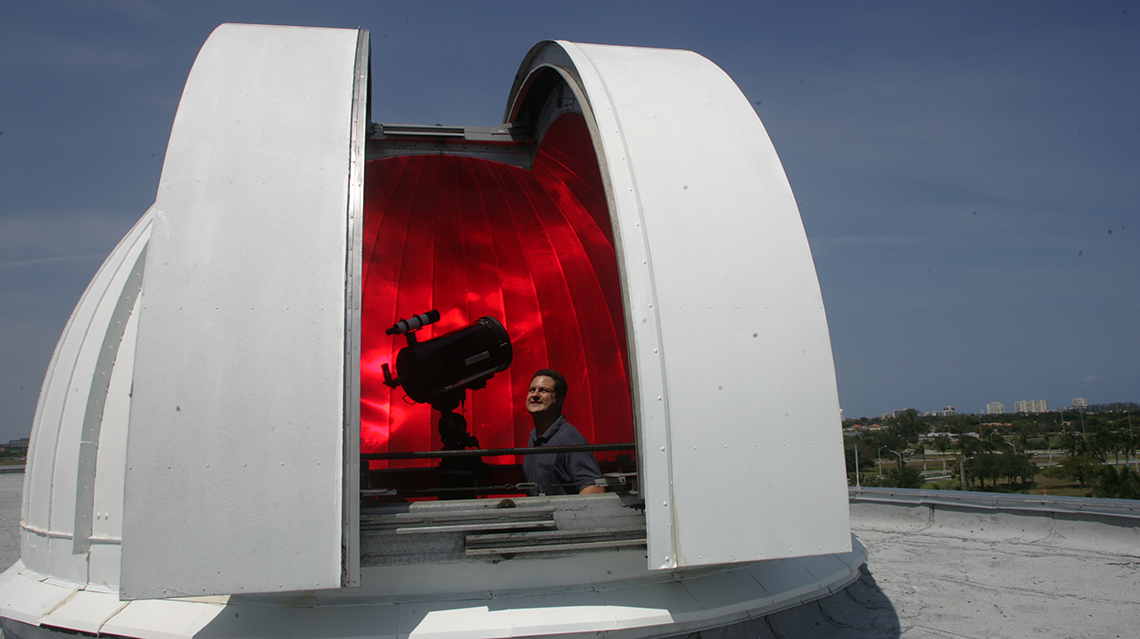
Welcome to the Observatory's Front Page. Included here are some of the latest news and articles that may be of interest to our visitors.
FAU's Astronomical Observatory is housed under a four meter diameter dome on the Boca Raton campus of Florida Atlantic University. We welcome students, faculty, staff and members of the general public to join our scheduled observations or our public viewing events. Our telescope is mounted on a small platform, at the top of stairs, looking out of the roof of our building, over Boca Raton, to space and beyond!
Section updated: Dec. 2nd, 2025.
I’ll be gone all day on the 5th to be with my son for his college orientation day.
We’ll have our 1st viewing session on the 12th and have a chance to witness a “celestial game of peek-a-boo” by two of Jupiter’s moon and a dim distant star. The game starts at 6:57 pm, when Jupiter and all will appear below our horizon. At that time, the solar system’s greatest moon, Ganymede, will pass into Jupiter’s shadow and go dark. It will do so from 33” (“arcseconds”) away from its edge. Note that Jupiter will appear 44 arcseconds across then, giving us a scale to understand these interactions by. So, when Jupiter rises, Ganymede won’t be visible to us. It will take Ganymede until 9:38-47 pm for it to finally become occulted by Jupiter’s mass, but just as it does so, is the same time that it will be emerging from the planet’s shadow, so it will remain hidden from our view! At 11:12:38 until 11:13:38 that dim star to the west of Ganymede will get occulted by the planet. But with it, this will happen as the star will appear to us to “touch” Jupiter, as the star’s light will pass right through Jupiter’s shadow to us. Compare that to how Ganymede that disappeared from 33” away. To show this to us, will come Io, which we will be able to see disappear into Jupiter’s shadow starting at 11:29:20 pm and take almost 4 minutes to completely disappear and be 14” away from the planet when it does. Finally, at 12:59 am, Dec. 13th, Ganymede will emerge from behind Jupiter and become visible to us. With careful observations, these actions occur because planet moves through space, and its moons orbit around it. If you know of anyone who has a hard time conceiving orbiting bodies and celestial mechanics in general, well then these events will clearly be evidence of its reality allowing them to personally witness such dynamics themselves. And of course, if Jupiter and its moons can do all of this, then why couldn’t our own planet and its Moon move through space, too!
Our planet Earth is orbiting nearer and nearer to Jupiter, but it still has a month to go before reaching opposition with Jupiter. It is becoming quite noticeable in our sky, especially as it appears so high up on the ecliptic. Its height from the horizon means that there will be little atmosphere in our way, so we can get more exquisite and detailed views of it. We’ll find it to the east of Pollux in Gemini. The planet will also appear near the planetary nebula NGC 2392.
But those peak-a-boo games won’t be the only thing that we’ll have to see that night. There will be plenty of things for us to see, as all the giant planets will be available to view! The sky will be quite dark, as the Waning Cresent Moon won’t rise until 0125 hrs on the 13th. The “Blue Snowball” (NGC 7662) planetary nebulae to see early on in the night. And to the south, we may be able to see the Sculptor Galaxy (NGC 253), which is 10 million light years away, and above and closer in, the Andromeda Galaxy, at 2.2 million light-years away, and the globular cluster M15 in Pegasus. And can see Orion’s Great Nebula and try once again to see if we can enter “Cluster 37” or just look in from the outside.
Early in the evening, an edge on ringed Saturn will be bookended by its moons Tethys, Rhea, Enceladus and Dione. We can also spy on the sky-blue planet Neptune and have a chance to see Neptune’s doomed moon of Triton. While the pale aqua planet Uranus will be seen less than 5° away from the Pleiades. Its spin axis is obliquely tilted over by 98° from the ecliptic plane. Because angular momentum is conserved, its axis always points out in the same direction in space. But now in its 84 year orbit, the planet has traveled around the Sun so that its north pole is oriented back at the Sun and us as well. So, when we observe it, we’ll be looking almost right upon its north pole.